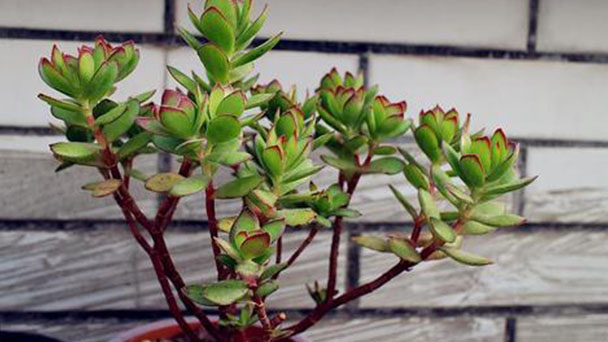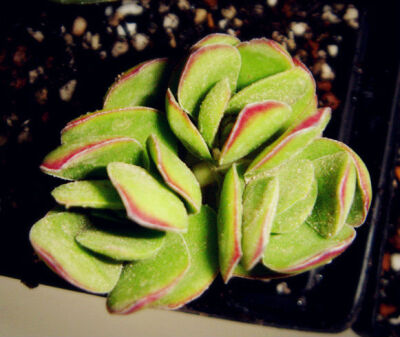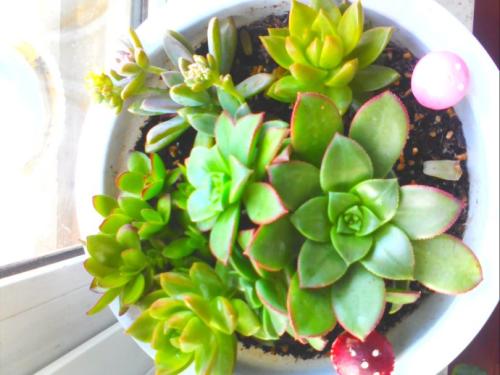Doily Crassula profile
Written by Maggie
Feb 04 2021

Doily Crassula, also called Crassula dejecta, is a succulent plant of the genus Cyclosaurus in the Chrysanthemum family. Doily Crassula originates from Mexico and is now widely cultivated in many parts of the world. Doily Crassula is a fleshy perennial herb with clusters of small branches and fleshy stems that gradually become semi-lignified over time. Doily Crassula has thin leaves with green leaves and maroon margins. Doily Crassula is pleasant to sunshine and cool, dry environment, resistant to half shade, afraid of waterlogging, avoid hot and humid.
Doily Crassula picture

Morphological characteristics of Doily Crassula
Doily Crassula is a fascicular plant with fine branches. The stem is fleshy. The stem is much branched, fascicular, cylindrical, with short internodes, fleshy and aerial roots. Seedling leaves of doily crassula are saplings; Leaves are thick, pink ochre, white surface, purplish halo.
Doily Crassula leaves reciprocal, petiolate sessile, basally joined, new leaves superimposed, adults slightly spaced. Flowers are white and bloom in spring. Doily Crassula is a fleshy perennial herb with a cluster of plants and tiny branches. The stem is fleshy, and the stem will gradually become semi-lignified over time. The leaves of Doily Crassula are a little thin, green in color, and the leaf margin is maroon, especially in late autumn and early spring when the temperature difference is large.
The distribution of Doily Crassula
Doily Crassula is a native of Mexico and is now grown in many parts of the world.

Doily Crassula growing method
1. Soil selection
The soil can be mixed with coal cinder peat and a small amount of perlite, with a ratio of about 5:4:1. The soil surface is paved with small stones. The newly bought seedlings of Doily Crassula can be directly mixed with peat soil and perlite so that the root is the fastest! Doily Crassula needs to keep the soil moist during the growing season to avoid water accumulation. The soil kite uses coal cinder mixed with peat, a small amount of perlite, the ratio is about 5:4:1, and the soil surface is laid with small stones.
2. The temperature
Doily Crassula can withstand the low temperature of about -2 ℃, indoor temperature, not outdoor temperature. At the lower point of growth, frostbite will appear at the top of the leaf, which will dry up and die. Next year, new lateral branches of Doily Crassula will re-sprout at the withered place.
3. Light
Every year from autumn to summer of the following year for the plant growth period (flower friends of the environment are not the same, the growth period also has a length, summer high temperature will hibernate, do not old watering). If the light is insufficient, the plant will grow fruitlessly, the distance between leaves will lengthen, making the plant shape lose, the stem will become very fragile, and the reddish-brown of the leaf margin will decrease and turn green. Doily Crassula grows in full sunlight, on the other hand, will be short and stout, and the nodes will be tightly arranged.
4. Water
Keep the soil moist during the growing season to avoid standing water. Doily Crassula can withstand the low temperature of about -2 ℃, indoor temperature, not outdoor temperature. At the lower point of growth, frostbite will appear at the top of the leaf, which will dry up and die. Next year, new lateral branches will re-sprout at the withered place. The whole winter basic water, 5 degrees below the start of slow water. The whole Doily Crassula grows slowly or completely stops when summer high temperature, this time should be well ventilated and appropriate shading, avoid insolation, temperate watering, cannot long-term rain, so as to avoid plant decay.
5. Pruning
Doily Crassula needs frequent pruning during the breeding process, cutting off disorderly branches to maintain a beautiful body shape. It is one of the fast-growing species of Cyanosaurus.
6. Winter maintenance
Doily Crassula can withstand the low temperature of about -2 ℃, indoor temperature, not outdoor temperature. At the lower point of growth, frostbite will appear at the top of the leaf, which will dry up and die. Next year, new lateral branches will re-sprout at the withered place. The whole winter basic water, 5 degrees below will begin to slowly cut off water. The whole plant grows slowly or completely stops when summer high temperature, this time should be well ventilated and appropriate shading, avoid insolation, temperate watering, cannot long-term rain, so as to avoid plant decay.
Doily Crassula method of propagation
Doily Crassula is cut in the growing season. Before cutting, the cuttings are slightly air-dried for 1 to 2 days. After cutting, the cuttings are protected from rain and keep a little moisture, which makes it easy to root. The propagation of Doily Crassula usually means cutting off the head, taking the healthy branches with growing points, cutting them in a section about 3-5cm high, drying the wound and cutting them, or directly cutting them in the dry granule soil. After a few days, a small amount of water is given to them. Doily Crassula is a variety that is very good for reproduction, and it is easy to grow many small roots between leaves. When it touches the right soil, it sets the roots firmly in. Beheaded propagation of Doily Crassula also has the advantage that it can make the mother plant get a better shape, the flower friends can try, the place after the beheading will re-germinate a new growth point, some will germinate 2 branches.
Doily Crassula application value
Doily Crassula is a fast-growing plant of Cyclosaurus genus, suitable for individual pot ornamental.

Latest Updated
- Benefits of Bugleweed - 7 Science-backed Health Benefits
- Bugleweed Dangers & Side Effects - Is It Poisonous?
- How to Plant Evergreen Trees - What You Should Know
- When to Plant Evergreens - Grow Guide for Evergreen Trees
- 12 Wonderful Evergreen Shrubs for Your Garden
- 12 Popular Evergreen Plants with Pictures for Beginners
- When And How To Prune A Lilac Bush Like a Pro
- How to Grow & Care for Lilac Vine (Hardenbergia Violacea)
- Japanese Lilac Tree (Syringa Reticulata) Care & Propagation Guide
- Shumard Oak Pros and Cons - What to Know
Popular Articles
- Winter maintenance of Antirrhinum Majus
- How to Grow Terminalia Mantaly Tree
- How to Grow and Care for Crossostephium Chinense
- How to grow Antirrhinum Majus in spring
- Peristeria Elata (Dove Orchid) Profile: Info & Care Guide
- Underwatered Snake Plant (Sansevieria Trifasciata) - Signs And How To Fix
- How to Care for Brazilian Jasmine Plant (Mandevilla Sanderi)
- How to Grow & Care for Graptopetalum Purple Delight in Summer
- Rosa Chinensis (China Rose): Plant Growing & Care Tips
- How to Care for Baby Sun Rose (Aptenia Cordifolia)